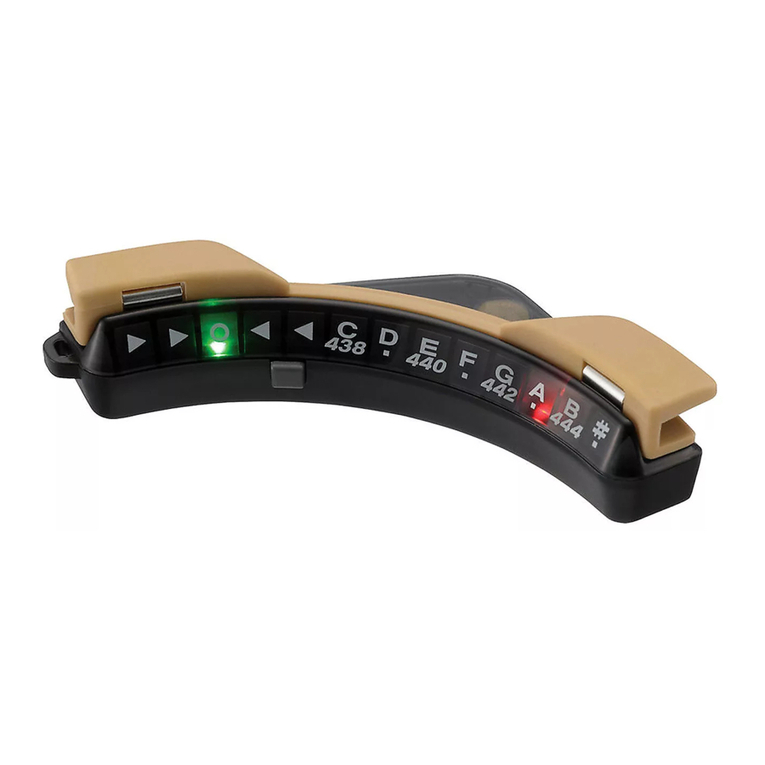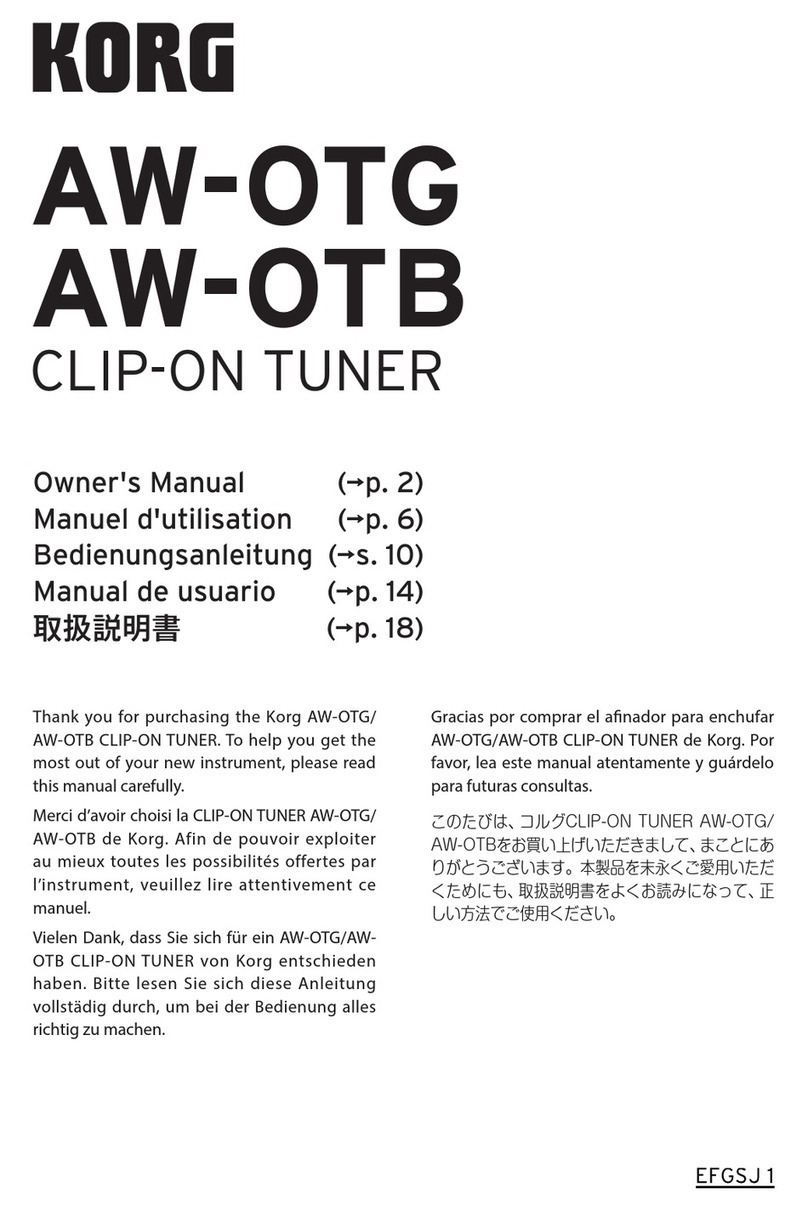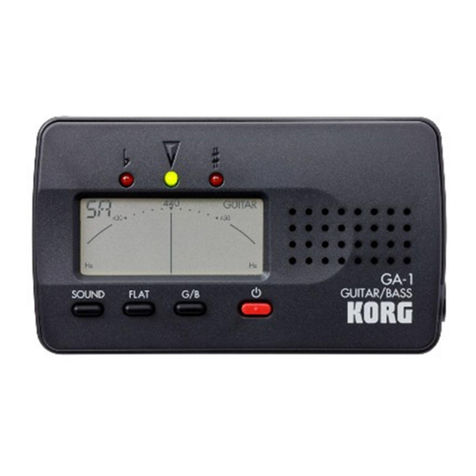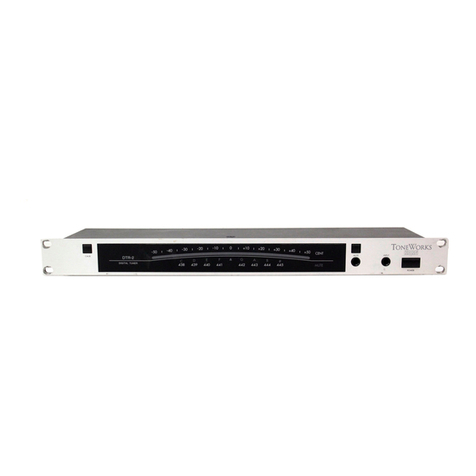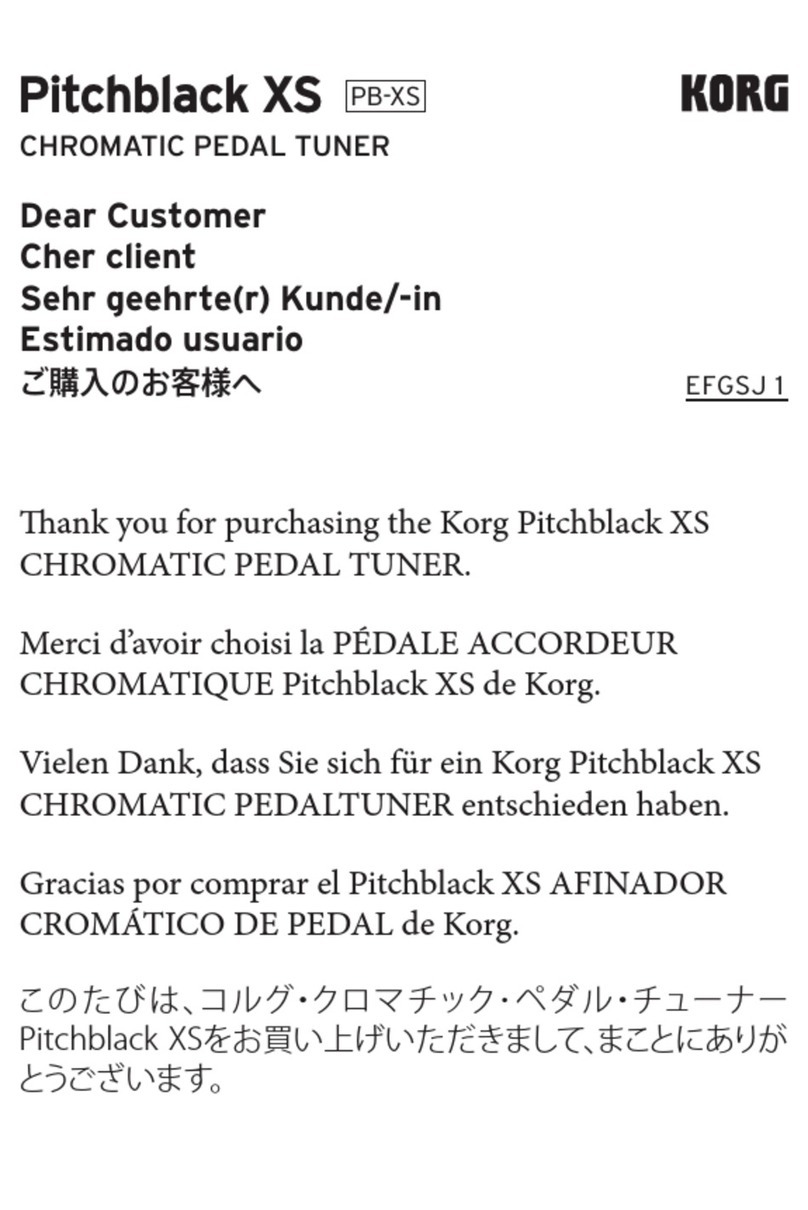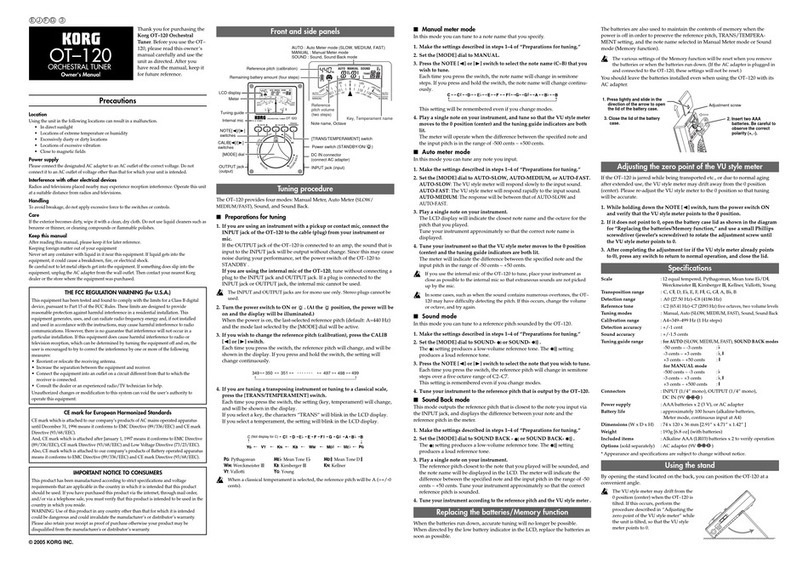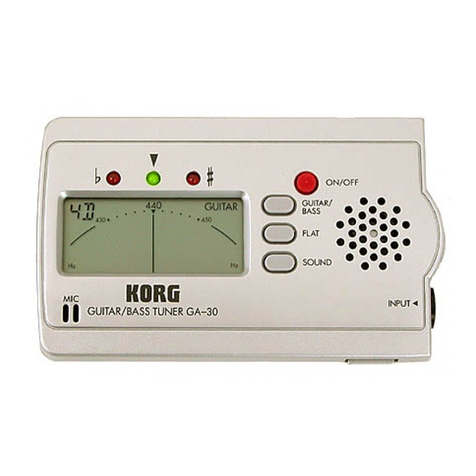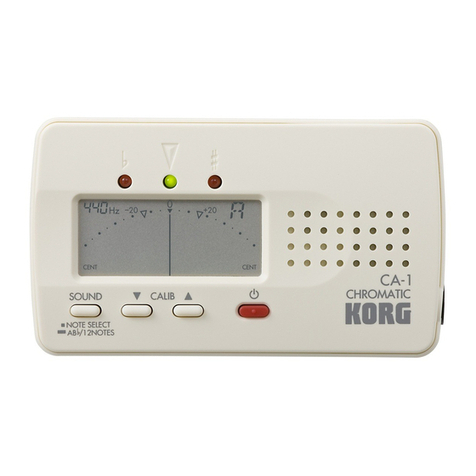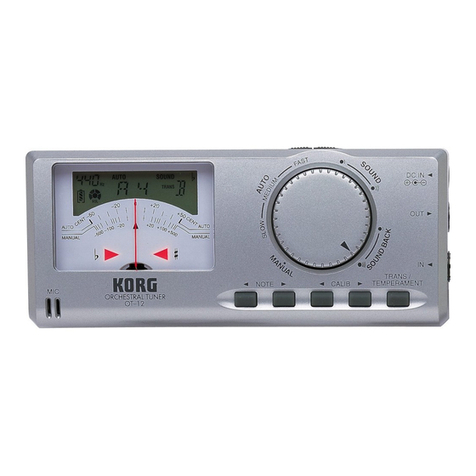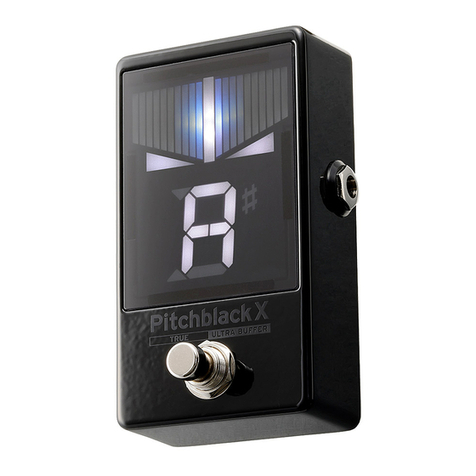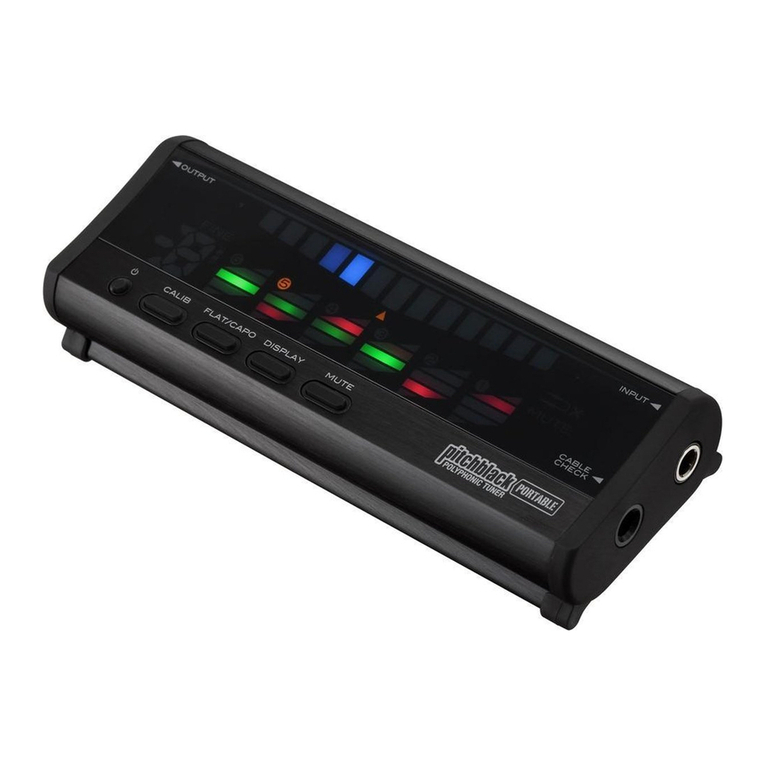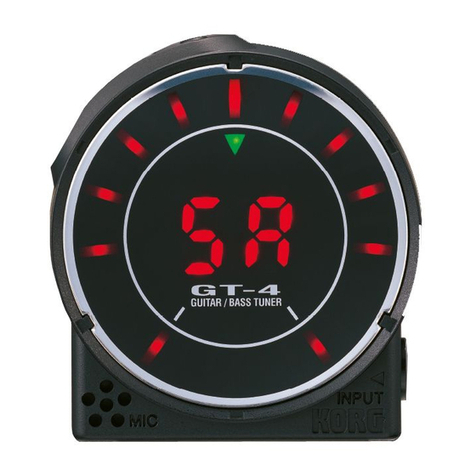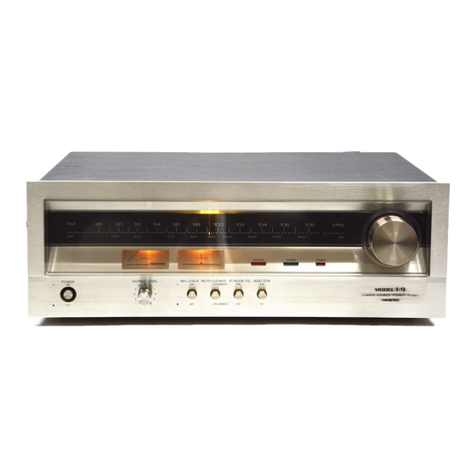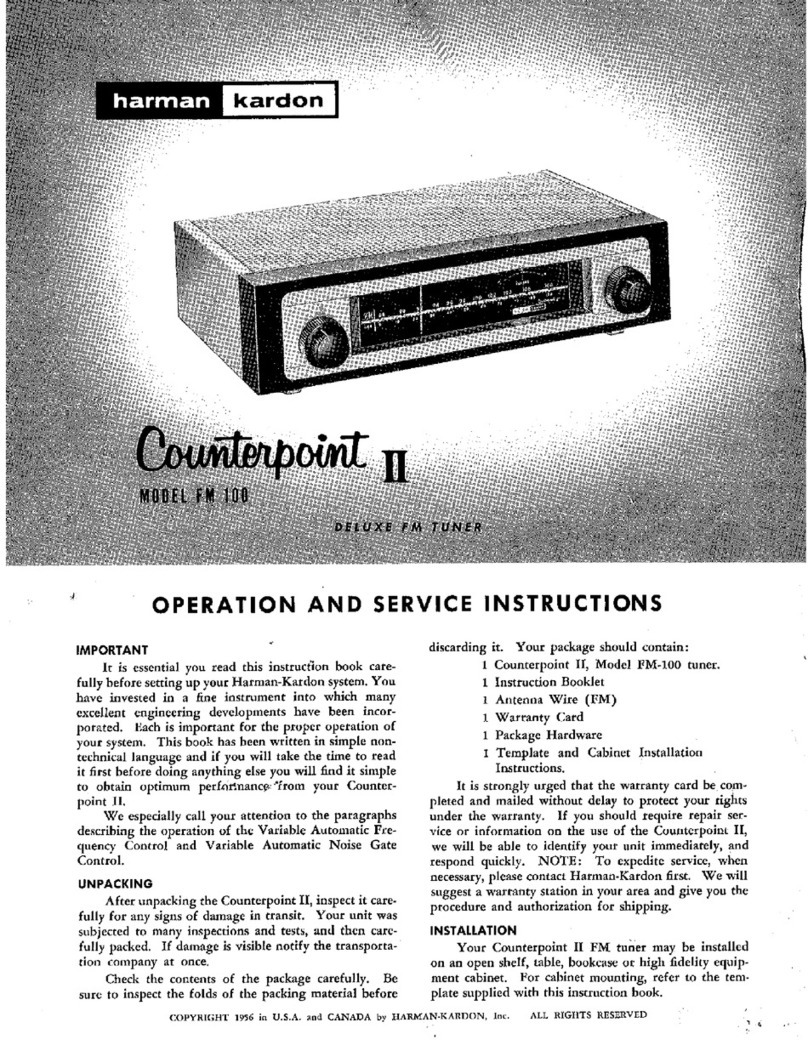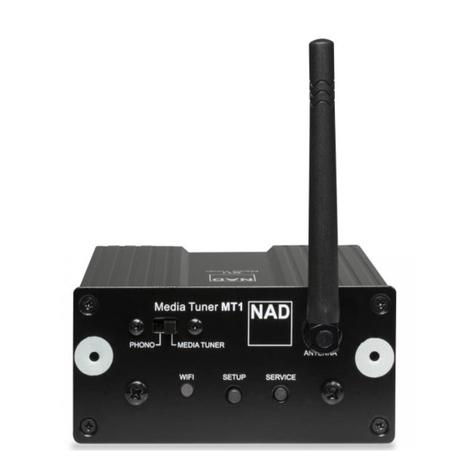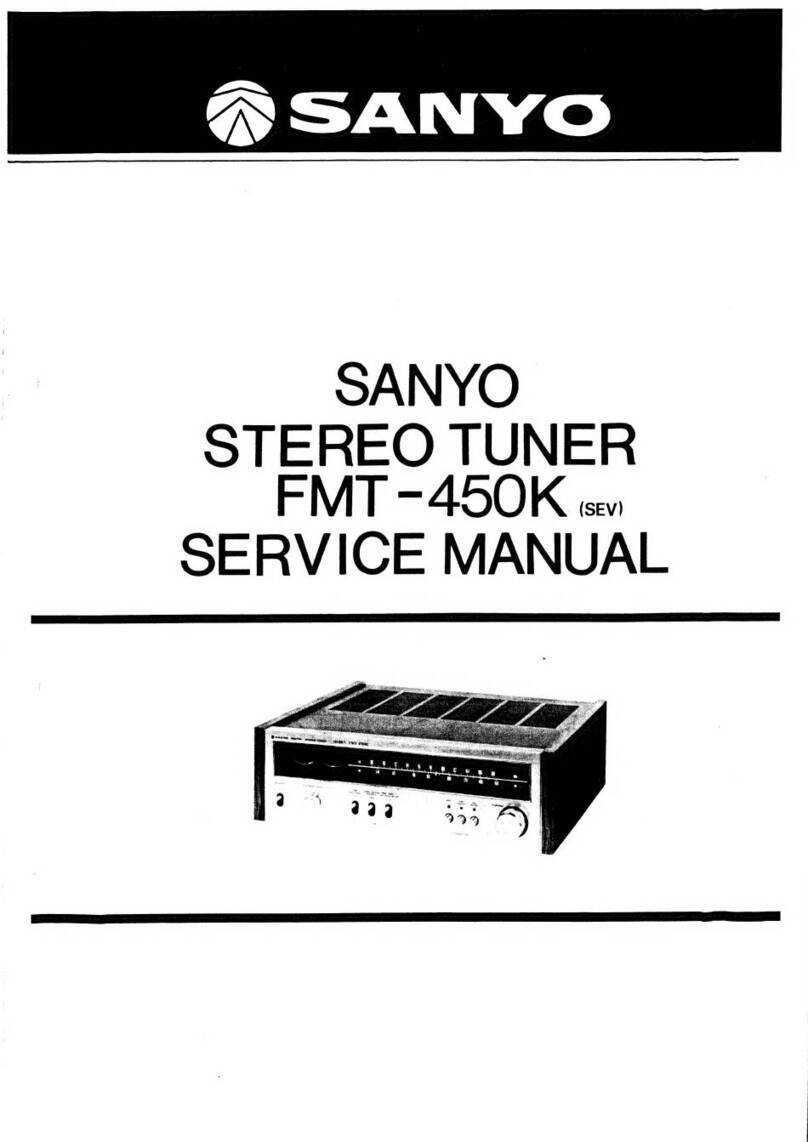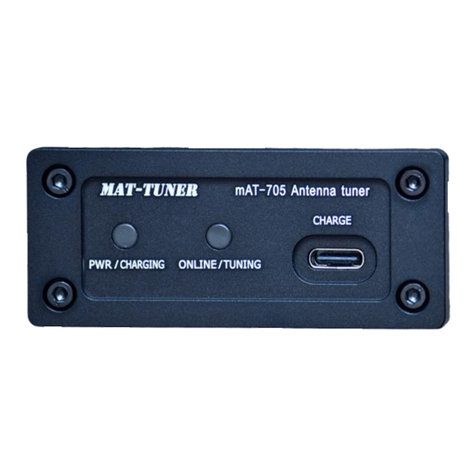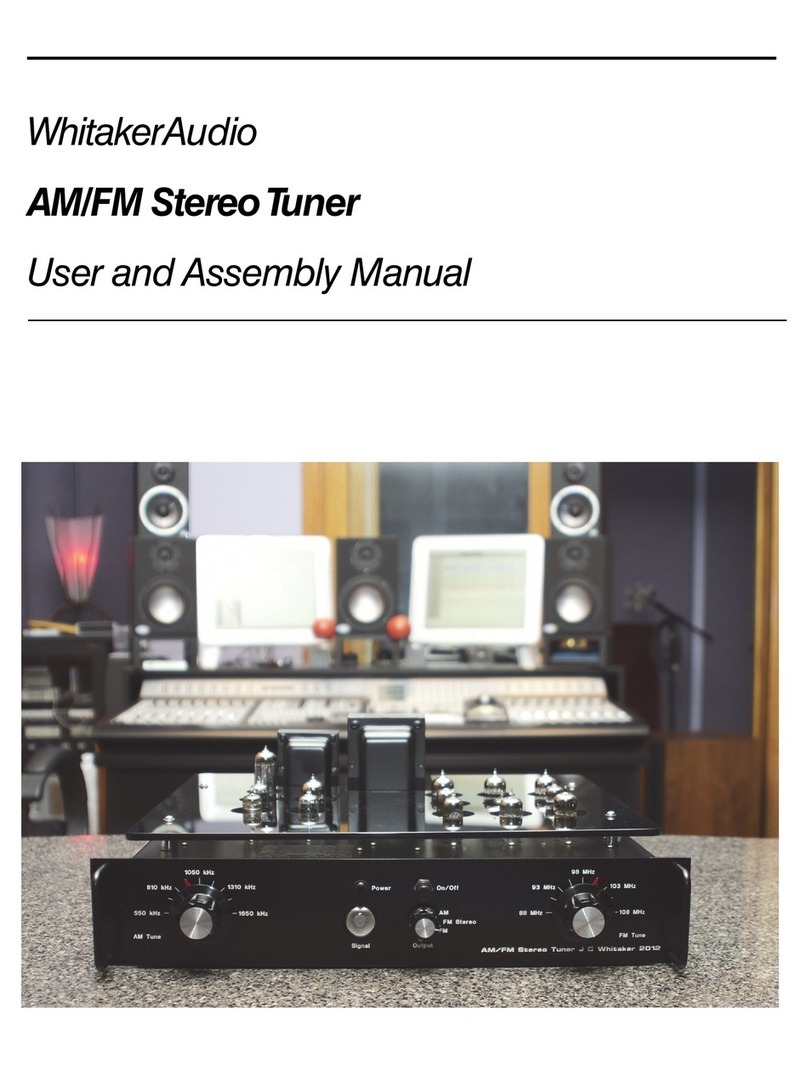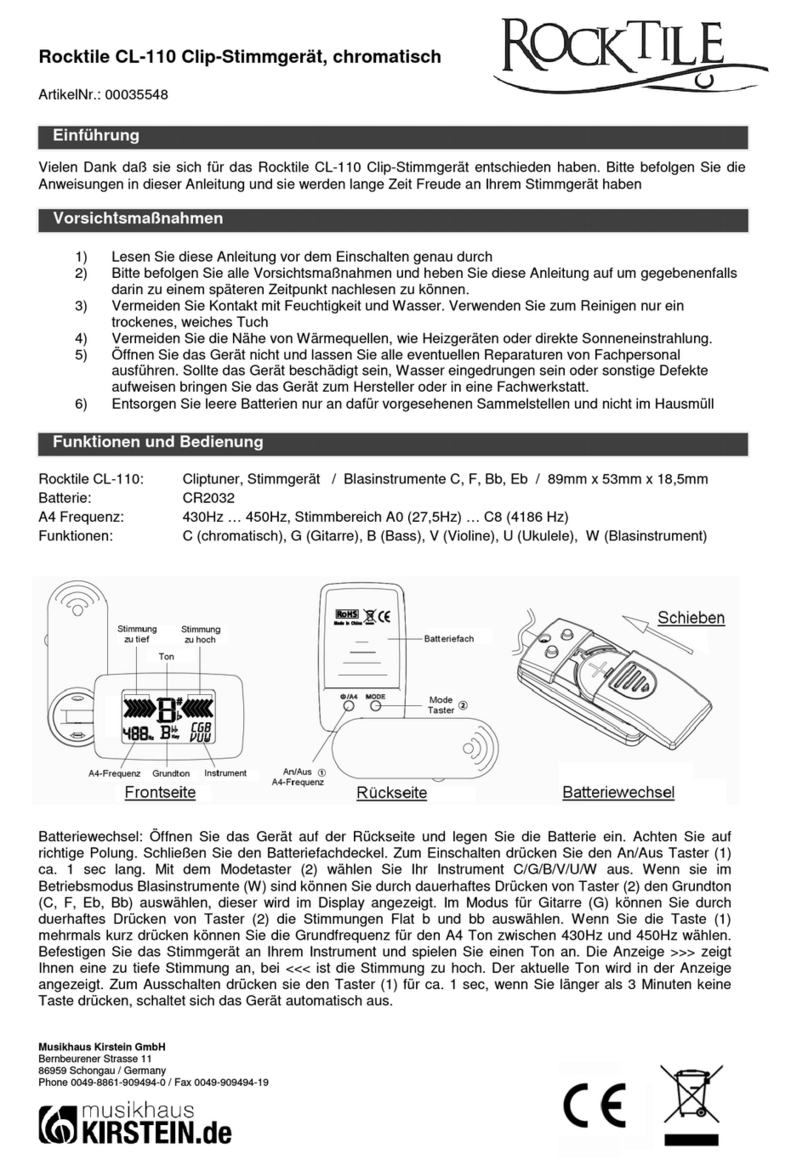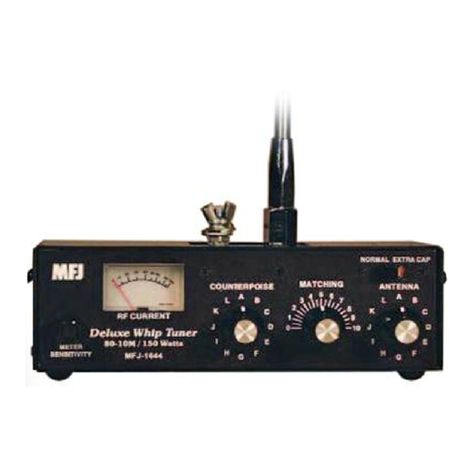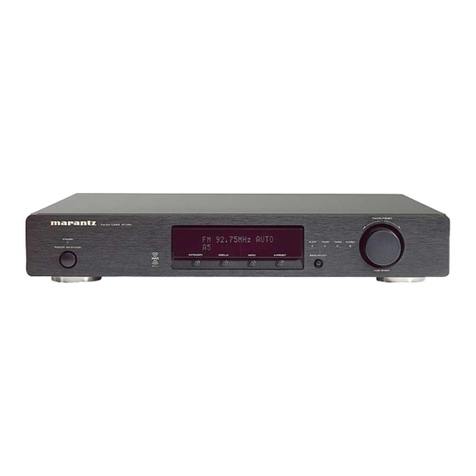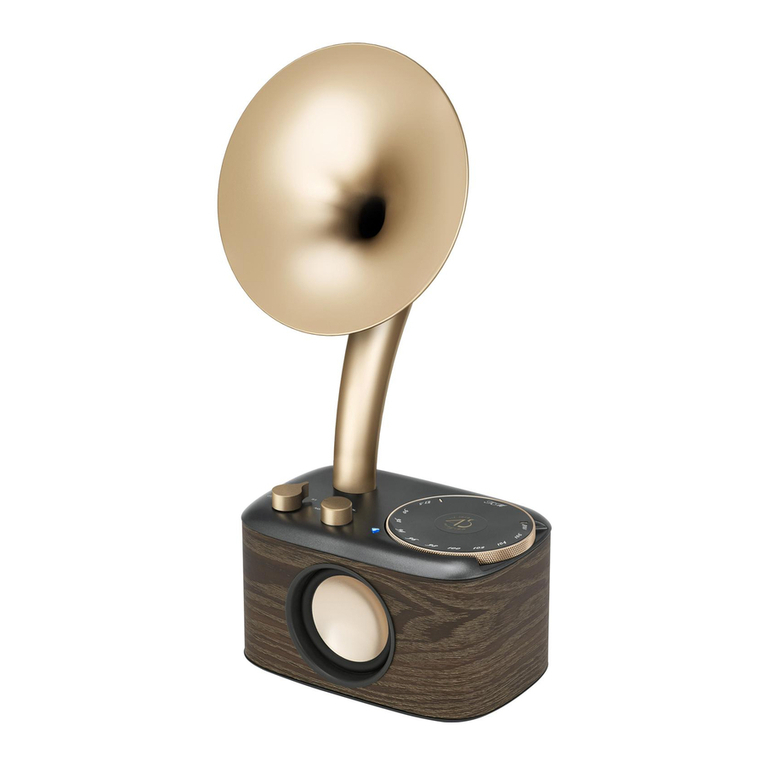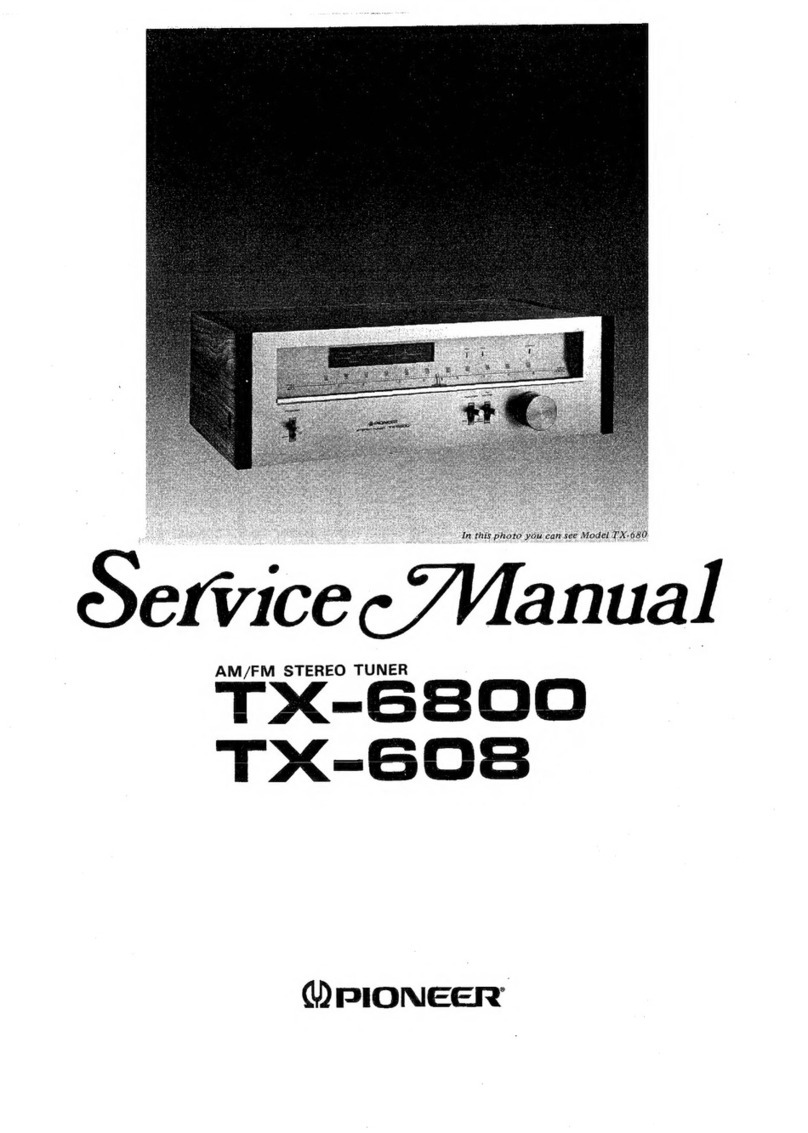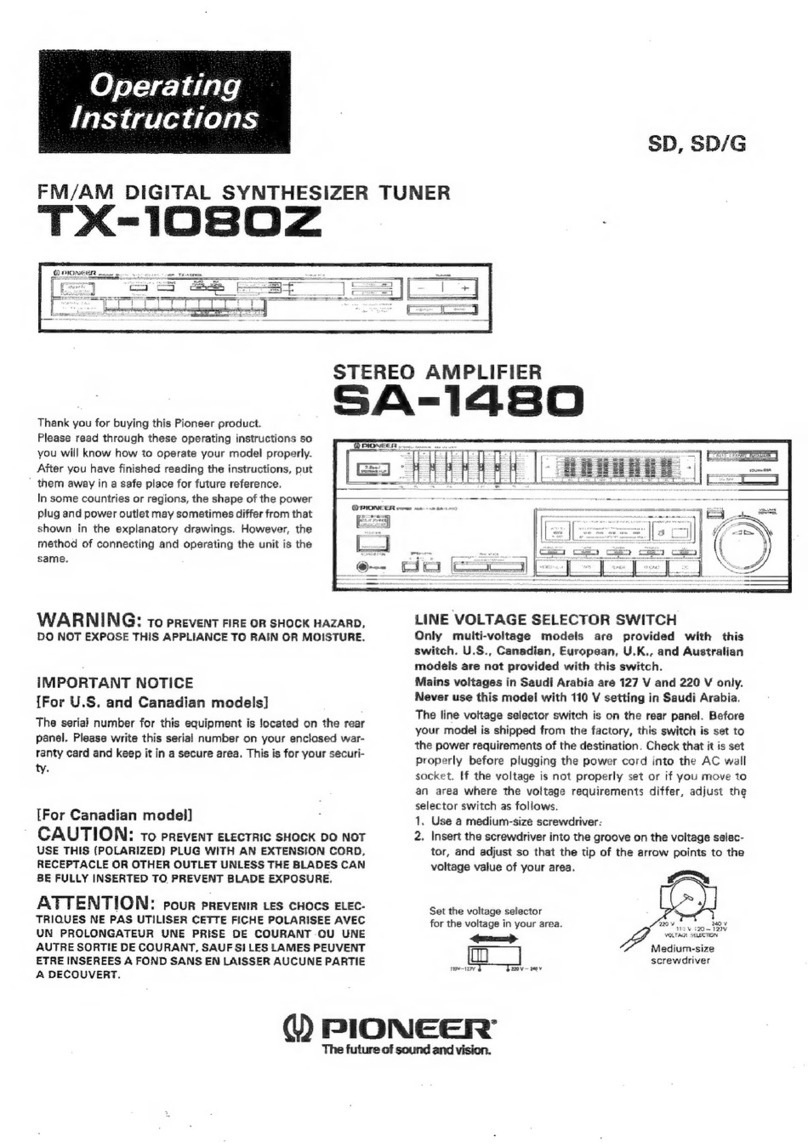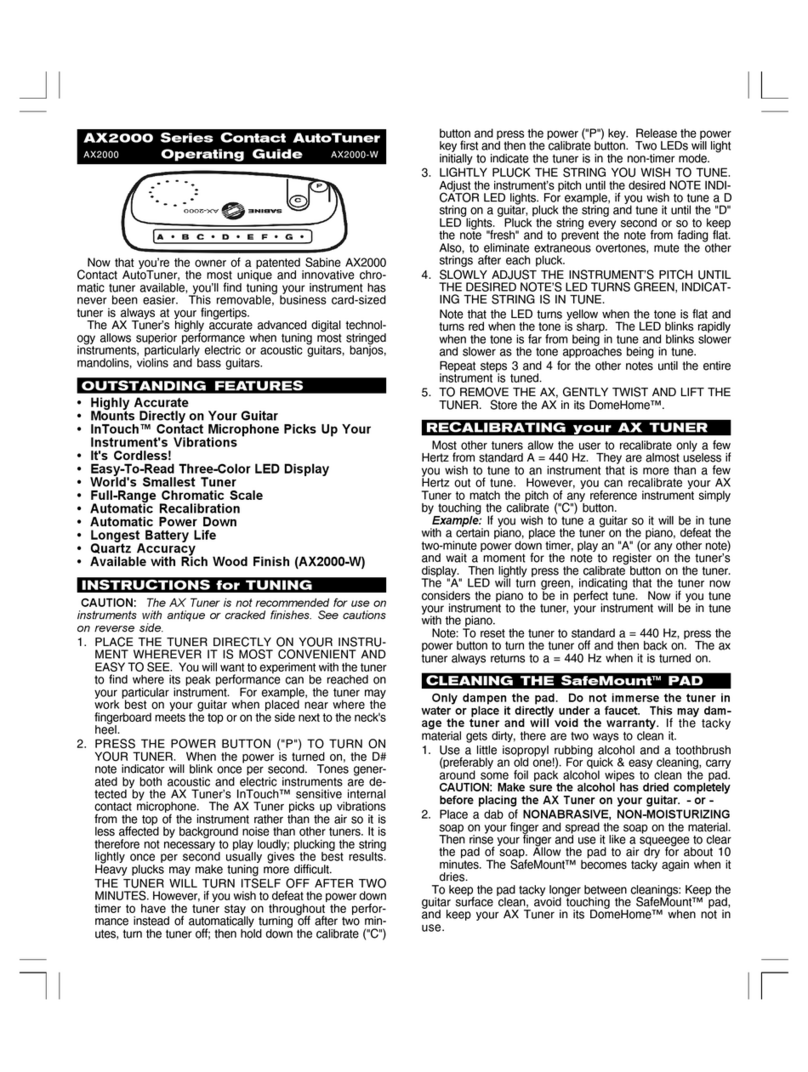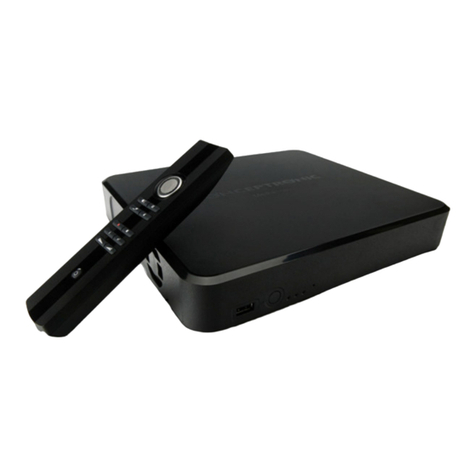Korg Wi-Tune WR-01 User manual

2
Precautions
Location
Using the unit in the following locations can result in a malfunction.
• In direct sunlight
• Locations of extreme temperature or humidity
• Excessively dusty or dirty locations
• Locations of excessive vibration
• Close to magnetic fields
Power supply
Be sure to turn the power switch to OFF when the unit is not in use.
Remove the battery in order to prevent it from leaking when the unit
is not in use for extended periods.
Interference with other electrical devices
Radios and televisions placed nearby may experience reception
interference. Operate this unit at a suitable distance from radios and
televisions.
Handling
To avoid breakage, do not apply excessive force to the switches or
controls.
Care
If the exterior becomes dirty, wipe it with a clean, dry cloth. Do not
use liquid cleaners such as benzene or thinner, or cleaning
compounds or flammable polishes.
Keep this manual
After reading this manual, please keep it for later reference.
Keeping foreign matter out of your equipment
Never set any container with liquid in it near this equipment. If liquid
gets into the equipment, it could cause a breakdown, fire, or
electrical shock. Be careful not to let metal objects get into the
equipment.
CAUTION
Risk of Explosion if Battery is replaced by an incorrect type. Dispose
of used batteries according to the instructions.
THE FCC REGULATION WARNING (for USA)
This equipment has been tested and found to comply with the
limits for a Class B digital device, pursuant to Part 15 of the FCC
Rules. These limits are designed to provide reasonable
protection against harmful interference in a residential
installation. This equipment generates, uses, and can radiate
radio frequency energy and, if not installed and used in
accordance with the instructions, may cause harmful
interference to radio communications. However, there is no
guarantee that interference will not occur in a particular
installation. If this equipment does cause harmful interference to
radio or television reception, which can be determined by
turning the equipment off and on, the user is encouraged to try
to correct the interference by one or more of the following
measures:
•Reorient or relocate the receiving antenna.
•Increase the separation between the equipment and receiver.
•Connect the equipment into an outlet on a circuit different from
that to which the receiver is connected.
•
Consult the dealer or an experienced radio/TV technician for help.
Unauthorized changes or modification to this system can void
the user’s authority to operate this equipment.
This device complies with Part 15 of the FCC Rules. Operation
is subject to the following two conditions: (1) This device may not
cause harmful interference, and (2) this device must accept any
interference received, including interference that may cause
undesired operation.
Complies with Canadian ICES-003 Class B.
Conforme au Reglement Canadian NMB-003 classe B.

3
Operation is subject to the following two conditions :
(1) this device may not cause interference, and
(2) this device must accept any interference, including
interference that may cause undesired operation of the device.
The installer of this radio equipment must ensure that the
antenna is located or pointed such that it does not emit RF field
in excess of Health Canada limits for the general population;
consult Safety Code 6, obtainable from Health Canada’s website
www.hc-sc.gc.ca/rpb
CALIFORNIA USA ONLY
This Perchlorate warning applies only to primary CR
(Manganese Dioxide) Lithium coin cells sold or distributed ONLY
in California USA.
“Perchlorate Material–special handling may apply,
See www.dtsc.ca.gov/hazardouswaste/perchlorate.”
European Union Directives
Conformance Statement
Korg Inc. hereby declares that the product meets
the requirements of Directive 1999/5/EC.
You can view the Declaration of Conformity(DoC)
to Directive 1999/5/EC in the Owner's Manual of
this product posted on the Korg website
(www.korg.com).
Notice regarding disposal (EU only)
When this “crossed-out wheeled bin” symbol is displayed
on the product, owner’s manual, battery, or battery
package, it signifies that when you wish to dispose of this
product, manual, package or battery you must do so in an
approved manner. Do not discard this product, manual,
package or battery along with ordinary household waste.
Disposing in the correct manner will prevent harm to
human health and potential damage to the environment.
Since the correct method of disposal will depend on the
applicable laws and regulations in your locality, please
contact your local administrative body for details. If the battery
contains heavy metals in excess of the regulated amount, a
chemical symbol is displayed below the “crossed-out wheeled bin”
symbol on the battery or battery package.
IMPORTANT NOTICE TO CONSUMERS
This product has been manufactured according to strict
specifications and voltage requirements that are applicable in
the country in which it is intended that this product should be
used. If you have purchased this product via the internet,
through mail order, and/or via a telephone sale, you must verify
that this product is intended to be used in the country in which
you reside.
WARNING: Use of this product in any country other than that for
which it is intended could be dangerous and could invalidate the
manufacturer’s or distributor’s warranty.
Please also retain your receipt as proof of purchase otherwise your
product may be disqualified from the manufacturer’s or distributor’s
warranty.
*All product names and company names are the trademarks or
registered trademarks of their respective owners.

4
Thank you for purchasing the Korg Wi-Tune WR-01 Wireless Tuner. To help you get the most out
of your new tuner, please read this manual carefully.
Part names
[POWER] button
[SOUND UP] button
[CALIB UP] button
[CALIB DOWN] button
[SOUND DOWN] button
Built-in microphone
[SOUND] button
[BACKLIGHT] button
Tuning guide indicator
LCD display
WR-01 (Tuner)
Wireless indicator
WR-01 low battery indicator
WR-TX low battery indicator
ID indicator
Microphone indicator

5
Power LED
[POWER] button
WR-TX (Transmitter)
Installing batteries
Please don’t charge an alkaline battery.
Before you install or replace the batteries on
your WR-01 or WR-TX, be sure to turn off
the power to both the transmitter as well as
the tuner. The batteries that are included are
intended to allow you to check functionality
and may have a short life.
If the batteries for the WR-01 or WR-TX are low
on power, the low battery indicator will appear
on the LCD display of the WR-01. Both units
will continue to work for a while, but tuning
may not be accurate. Please replace the
batteries with new ones as soon as possible.
Installing batteries in the WR-01
1. Gently press down and slide the battery
case cover on the rear panel of the WR-01
to remove it.
2. Properly orient the batteries and insert
them into the unit.
3. Reattach the battery cover on the WR-01.
Installing batteries in the WR-TX
CR2032 batteries that are compatible with the
WR-TX
CR2032 batteries made by Panasonic

6
1. Remove the clip that’s attached to the WR-
TX, then gently press down and slide the
battery case cover on the near panel of the
WR-TX to remove it.
2. Properly orient the battery and insert it into
the unit.
3. Reattach the battery cover on the WR-TX.
Attaching and removing the
supplied clip/strap on the WR-
TX
Insert the clip or strap into the clip attachment
groove on the WR-TX and slide it in all the way.
Make sure that you insert the clip or strap in
the correct orientation.
When you attach the clip do not touch the
connectors on the WR-TX.
Do not pull the clip by grasping the
pinching portion of the clip. Otherwise, the
clip or strap may break.
When you attach the clip or strap, be sure to
slide it in all the way until it is locked, then
make sure that it’s secure.
The attachment figure of Clip A
The attachment figure of Clip B

7
Attaching the WR-TX to your
musical instrument
The Wi-Tune measures the pitch of a musical
instrument by sensing vibrations from the
instrument. These vibrations are picked up by
the WR-TX, and wirelessly transmitted to the
WR-01. However, depending where the WR-TX
is attached to the instrument, the vibrations
may not be picked up very well. In this case, try
repostioning the WR-TX to pick up these
vibrations better.
The WR-TX can be attached to musical
instruments such as woodwind, brass or strings
instruments. With some musical instruments,
such as a saxophone, you can attach the WR-TX
to a strap or other part that vibrates, rather than
directly to the instrument itself.
Please refer to the attachment position
examples that are shown in the figures to the
right.
When you clip the WR-TX to or remove it
from the musical instrument, handle it
gently. Attaching the WR-TX to the musical
instrument for a long period of time may
leave a trace on the instrument.
The attachment figure of Strap

8
Applying excessive force to the WR-TX or
clip may cause damage.
WR-TX attachment position examples
The figure of the example of the
attachment position of Clip A
The figure of the example of the
attachment position of Clip B
The figure of the example of the
attachment position of Clip A
Using the WR-01 stand

9
Setting the ID after replacing
the WR-TX
The ID setting data is shared by the WR-01 and
WR-TX. This is done to prevent signal scramble
during wireless communication.
An ID was programmed into the WR-01 and
WR-TX supplied in this Wi-Tune package
before they shipped from the factory.
If you are using a different WR-TX (that was
not included in this package), you must set the
ID on that WR-TX.
1. Gently press down and slide the cover on
the right side of the WR-01 to remoce it.
2. Slide the WR-TX into the WR-01 so that the
WR-TX will lock into the WR-01's connector.
You can do this while the power to each
unit is turned on.
When the transmission of the ID data from the
WR-TX to the WR-01 is complete, the ID indica-
tor will light up on the LCD.
3. Turn on the power to the WR-TX and WR-01.
You can do this while the power to each
unit is turned on.
When the transmission of the ID data from the
WR-TX to the WR-01 is complete, the ID indica-
tor will light up on the LCD.
4. After the ID data is transmitted, remove the
WR-TX from the WR-01.
The ID indicator on the LCD will turn.
If multiple Wi-Tune units are used in the

10
same location, the tuning meter may not
respond to the proper instrument, or an
incorrect note name may be displayed. In
such cases, resetting the ID will restore
communication between the WR-TX and
WR-01.
If there is no input sound for 20 minutes
while the WR-TX is turned on, or if the
WR-TX and WR-01 cannot communicate
with each other for two minutes, the
power will automatically be turned off.
Turning the power on and off
1. Press the [POWER] button on the WR-01
and WR-TX to turn the power on and off.
If there is no input sound for 20 minutes while the
WR-01 is turned on, the power will automatically
be turned off.
Backlight
1. Press the [BACK LIGHT] button. The LCD
backlight will turn on.
Pressing the [BACK LIGHT] button will turn the
LCD backlight on and off.
Wireless tuning
Once the power to the WR-TX is turned on and
communication becomes possible, the built-in
microphone of the WR-01 will turn off,
enabling you to use the wireless function. At
this time, the wireless indicator will appear on
the LCD.
Tuning via wireless microphone
You can use the built-in microphone on the
WR-01 by only turning on the power to the
WR-01. At this time, the MIC indicator on the
LCD will turn on.
Once wireless tuning is enabled, the WR-01
will maintain wireless tuning mode even if
it is unable to receive a signal because the

11
power to the WR-TX is turned off, the
batteries on the WR-TX are exhausted, or
the WR-TX is moved outside the range of
communication. If you want to switch the
WR-01 to microphone tuning mode, turn off
the power to both the WR-01 and WR-TX,
then turn on the power to the WR-01 only.
Meter mode
When you turn on the power to both units, the
Wi-Tune will enter meter mode. In this mode,
you can tune your instrument by looking at the
meter and using the transmitter or the built-in
microphone on the receiver.
1. Press the [CALIB UP] button or the [CALIB
DOWN] button to select the reference pitch.
You can adjust the reference pitch in 1Hz steps
in the range of 410Hz to 480Hz.
2. Play a single note on your musical
instrument to tune.
The WR-01 displays the name of the note closest
to the recognized pitch. Tune your instrument so
that the WR-01 displays the note name that you
are turning to.
3. Play a single note again and tune your
instrument so that the tuning guide
indicator (the center of the meter) will turn
on.
When you are using the WR-01's built-in
microphone for tuning, try to avoid
allowing sounds from sources other than
the instrument to be picked up by the
microphone.
Even within the measurable range, a note
with lots of harmonics or a quick decay may
not be measurable (e.g., especially notes in
the extreme bass or treble range of the
piano).
When the WR-TX is turned off, only built-in
microphone tuning is available on the WR-
01.
To raise a pitch by a pure major 3rd or a
pure minor 3rd, adjust the tuning so that
the meter needle will point to the pure
major or minor 3rd mark respectively. For
example, if you want to raise the note of A
(0 cent) by a pure major 3rd, first tune your
instrument so that the display will indicate

12
the note name C#, then fine-tune the
instrument so that the meter needle will
point the down arrow ▼(–13.7 cents) on the
left side of the meter. If you want to raise
the note of A (0 cent) by a pure minor 3rd,
tune your instrument so that the display
will indicate note name C, then fine-tune
the instrument so that the meter needle will
point the up arrow ▼(+15.6 cents) on the
right side of the meter.
Sound-out mode
In this mode, you can tune your instrument by
referring to the oscillator sound at the reference
pitch (output from the speaker of the WR-01).
1. Press the [SOUND] button to engage
sound-out mode.
2. Press the [SOUND UP] or [SOUND DOWN]
button to select the name of the that which
you want to tune to.
You can select a pitch in the range of C4
(261.63Hz) to C5 (523.25Hz).
3. Tune your instrument while referring to the
oscillator sound at the reference pitch
output from the receiver.
4.
To exit Sound-out mode, press the [SOUND]
button.

13
Specifications
Temperament: Equal temperament
Measurement range: A0 (27.50Hz) – C8 (4186.01Hz)
Reference pitch: C4 (261.63Hz) – C5 (523.25Hz); One octave
Tuning mode: Meter mode (AUTO); Sound-out mode (MANUAL)
Calibration range: A4=410 – 480Hz (1Hz steps)
Measurement precision: Within ±1 cent
Sound precision: Within ±1.5 cents
Wireless: 2.4GHz band
Speaker: Dynamics speaker (ø23mm)
Power: AA batteries (x 2) = 3V (Alkaline batteries recommended)
Dimensions: WR-01; ??mm(W) x ??mm(D) x ??mm(H)
WR-TX; ??mm (W) x ??mm(D) x ??mm(H)
Weight: WR-01; ??g (including batteries)
WR-TX; ??g (including batteries)
Clip; ??g
Battery life: WR-01; Approx. ??? hours (during tuner operation with backlight off, continu-
ous A4 input operation)
WR-TX; Approx. ??? hours
Accessories: Owner's Manual; AAbatteries (x2) for checking operation; CR2032 lithium bat-
tery (3V) (x1) for checking operation; Clips A and B and strap for attaching to
the musical instrument.
*Specifications and appearance are subject to change without notice for improvement.
Table of contents
Other Korg Tuner manuals
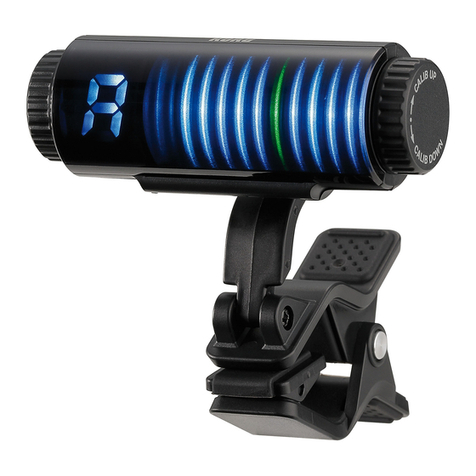
Korg
Korg Sledgehammer Pro User manual
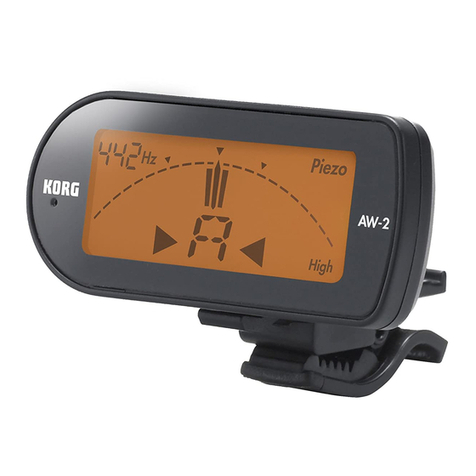
Korg
Korg AW-2 User manual
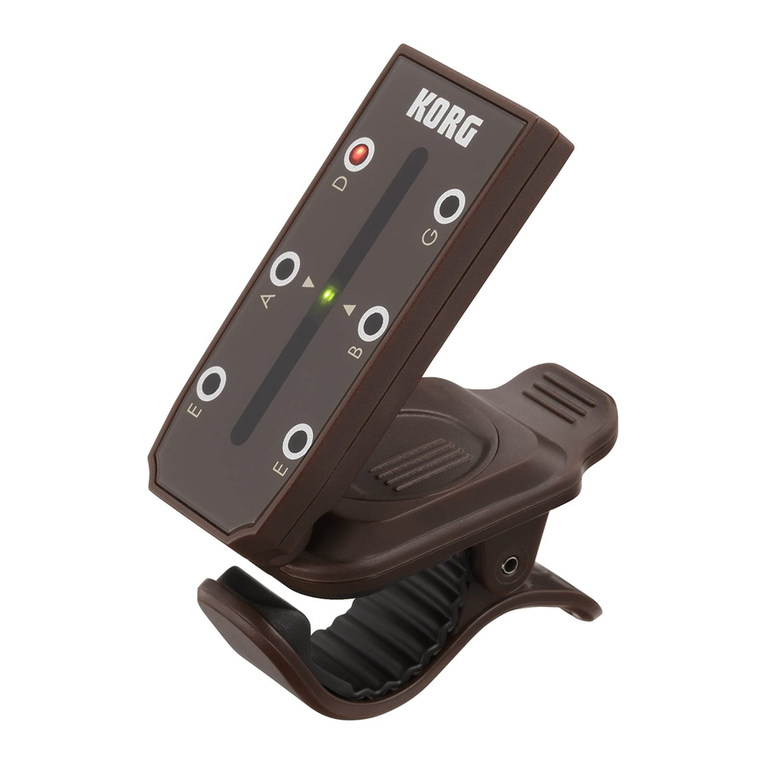
Korg
Korg HeadTune HT-G1 User manual
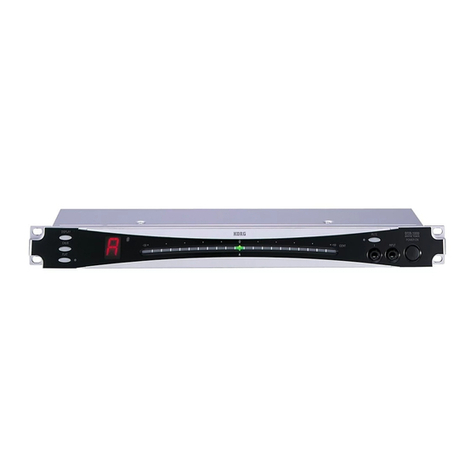
Korg
Korg DTR-1000 User manual
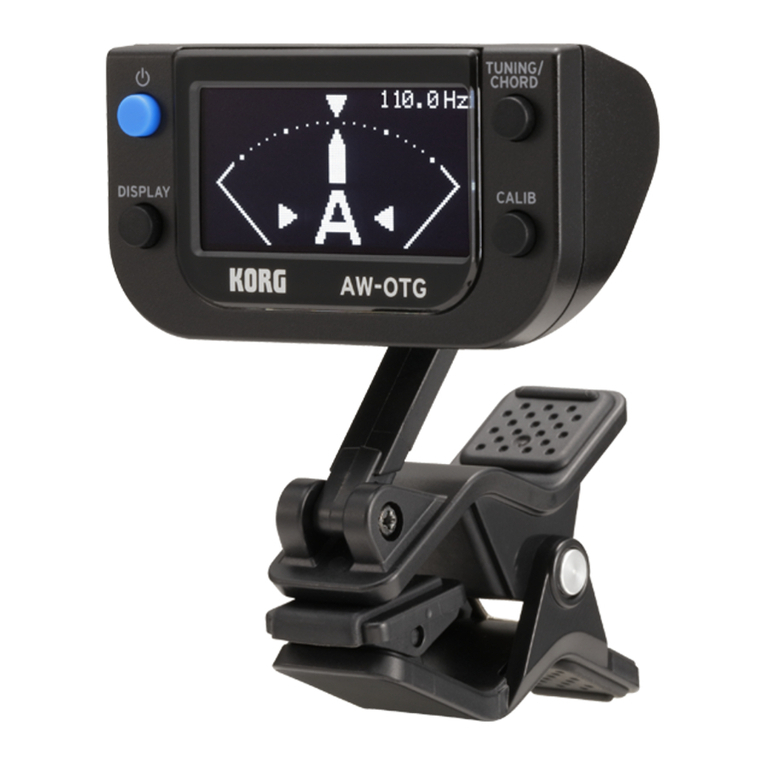
Korg
Korg AW-OTG User manual
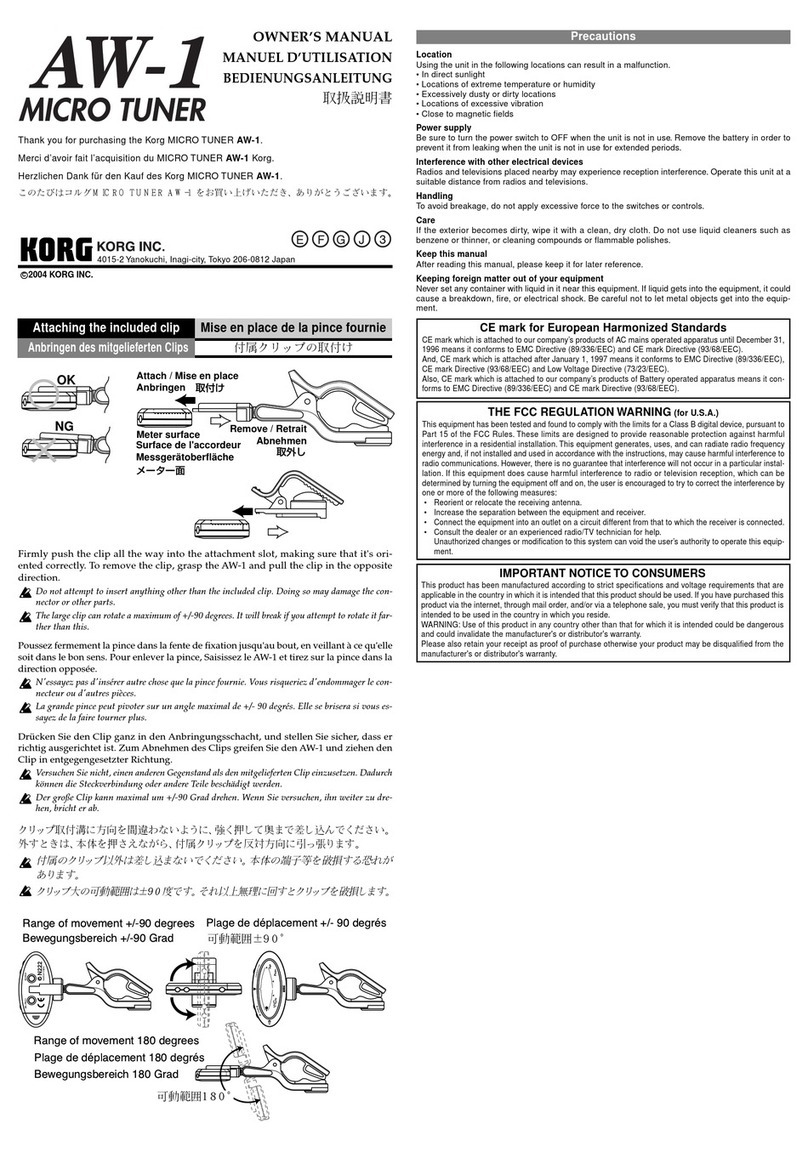
Korg
Korg AW-1 User manual
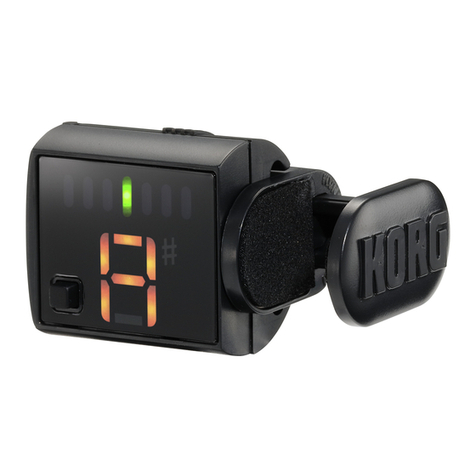
Korg
Korg GripTune User manual

Korg
Korg Pitchblack X mini User manual
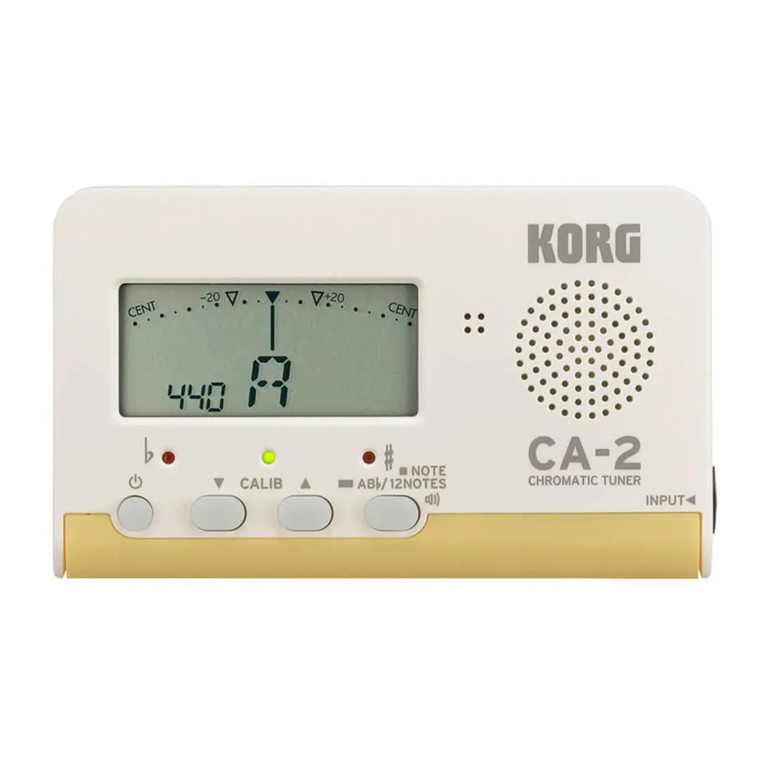
Korg
Korg CA-2 User manual
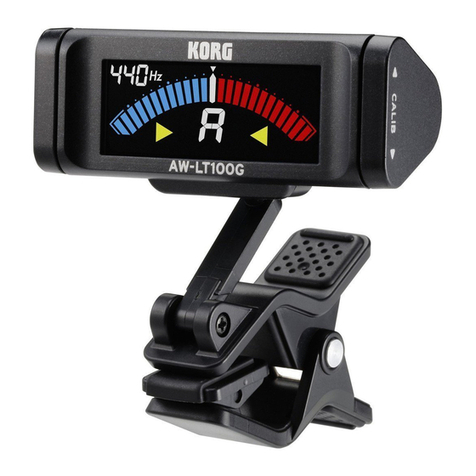
Korg
Korg AW-LT100G User manual
